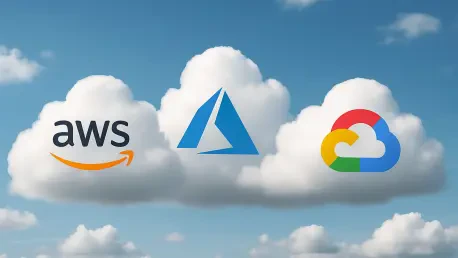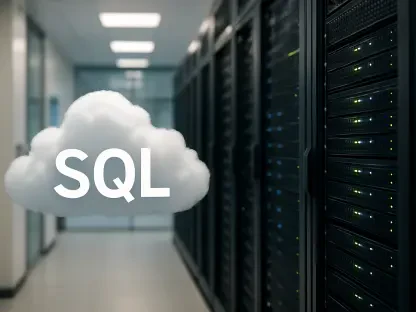In an era where digital transformation dictates the pace of business innovation, the reliance on a single cloud provider has become a relic of the past, giving way to sophisticated multicloud and hybrid cloud approaches that harness the unique strengths of multiple platforms. Amazon Web Services (AWS), Microsoft Azure, and Google Cloud Platform (GCP)—widely recognized as the “big three hyperscalers”—stand as pivotal forces in this evolving landscape. These giants have not only redefined how enterprises manage IT infrastructure but also introduced a “cloud-everywhere” philosophy that extends services beyond traditional public cloud boundaries to on-premises data centers and even rival clouds. This shift addresses critical challenges like data sovereignty, latency constraints, and the inertia of legacy systems, enabling businesses to craft flexible, resilient strategies tailored to their needs.
The distinct approaches of AWS, Azure, and GCP to multicloud environments reflect their historical roots and strategic visions, offering enterprises a spectrum of tools to navigate distributed setups. From flagship solutions like AWS Outposts, Azure Arc, and Google Cloud Anthos to specialized offerings in cost management and security, each provider brings a unique perspective to the table. Understanding these differences is essential for organizations aiming to optimize performance, ensure compliance, and manage costs effectively. As the cloud computing arena continues to mature, the interplay of innovation and competition among these hyperscalers shapes the very foundation of modern IT strategies, promising a future of seamless integration and intelligent automation.
Core Offerings for Multicloud and Hybrid Environments
AWS Outposts: Hardware-Centric Consistency
AWS Outposts represents a bold step in bringing the native AWS infrastructure directly into on-premises data centers, ensuring a uniform operating model for workloads that cannot be hosted in public cloud regions due to latency or regulatory constraints. This hardware-centric solution allows enterprises to run familiar AWS APIs and tools within their own environments, maintaining consistency across hybrid setups. It addresses a critical need for organizations that require low-latency processing or must adhere to strict data residency laws, providing a seamless extension of AWS services. By embedding its cloud capabilities into customer-controlled spaces, AWS demonstrates a pragmatic shift from a purely cloud-based model to one that meets enterprises where they are, blending the best of both worlds.
Beyond the technical integration, AWS Outposts underscores a broader commitment to flexibility, catering to industries like manufacturing or healthcare where on-site data processing is non-negotiable. The solution supports a wide array of applications, from real-time analytics to mission-critical systems, without forcing a complete migration to the public cloud. This approach not only mitigates the risks associated with data transfer but also leverages AWS’s extensive service catalog for scalability and innovation. Enterprises benefit from a unified experience, where the same tools used in AWS regions apply locally, reducing the learning curve for IT teams and ensuring operational continuity across diverse environments.
Azure Arc: Unified Management Across Platforms
Azure Arc stands out as a management-centric tool that extends Azure’s control plane to non-Azure resources, allowing governance and monitoring of heterogeneous environments through familiar Azure interfaces. This capability enables businesses to manage on-premises servers, edge locations, and even resources in other clouds as if they were native to Azure, streamlining operations across complex setups. By projecting these disparate elements into the Azure portal, the platform offers a cohesive framework for policy enforcement, security oversight, and resource tracking, making it a powerful ally for enterprises with mixed infrastructures.
The strength of Azure Arc lies in its ability to bridge the gap between legacy systems and modern cloud architectures, particularly for organizations already invested in Microsoft ecosystems. It facilitates a gradual transition to cloud services without disrupting existing workflows, offering tools like Azure Policy to ensure compliance across all managed resources. This unified approach reduces administrative overhead and enhances visibility, allowing IT teams to focus on strategic initiatives rather than fragmented management tasks. For businesses prioritizing hybrid integration, Azure Arc provides a robust foundation to harmonize diverse environments under a single operational lens.
Google Cloud Anthos: Application Portability with Kubernetes
Google Cloud Anthos leverages the power of Kubernetes to champion a software-first approach, enabling application portability across GCP, AWS, Azure, and on-premises environments with minimal refactoring. Rooted in Google’s pioneering contributions to container orchestration, Anthos allows developers to build applications once and deploy them consistently anywhere, addressing the challenge of environment-specific dependencies. This focus on application-centric management makes it an ideal choice for enterprises embracing modern development practices like microservices and containerization.
Additionally, Anthos prioritizes flexibility for developers by abstracting infrastructure complexities, ensuring workloads can move fluidly between clouds or local setups. Its Kubernetes-centric dashboards provide insights into cluster performance and resource allocation, supporting seamless operations across distributed systems. This portability is particularly valuable for businesses focused on rapid innovation, as it reduces lock-in risks and fosters an agile development cycle. By emphasizing open-source principles, Anthos aligns with the growing demand for interoperable solutions, positioning GCP as a leader in application modernization within multicloud strategies.
Strategic Philosophies and Historical Influences
AWS: The Cloud Pioneer’s Scalability Focus
AWS, as the trailblazer in cloud computing, has built its multicloud strategy on a foundation of unparalleled scalability and a comprehensive service catalog that caters to virtually every enterprise need. Its early entry into the market allowed it to establish a global infrastructure that remains unmatched in reach, offering businesses the ability to scale operations effortlessly across regions. This focus on breadth and flexibility ensures that AWS can support complex, customized environments, making it a go-to choice for organizations requiring a wide array of tools and robust performance capabilities.
The strategic vision of AWS also reflects a customer-centric evolution, adapting from a public cloud-only mindset to one that embraces hybrid realities through solutions like Outposts. This adaptability is rooted in its history of innovation, consistently expanding services to meet emerging demands, from machine learning to edge computing. Enterprises looking for a provider with a proven track record and extensive resources find AWS’s ecosystem particularly compelling, as it offers the building blocks for both current operations and future growth. This focus on scalability continues to define AWS’s role in shaping multicloud strategies worldwide.
Azure: Enterprise Roots with Hybrid Strength
Microsoft Azure draws on decades of experience in enterprise data centers to deliver a multicloud strategy that prioritizes hybrid integration, seamlessly connecting on-premises systems with cloud environments. Azure Arc exemplifies this approach, offering a unified management plane that simplifies governance for businesses already using Microsoft products like Windows Server or Microsoft 365. This deep-rooted familiarity with enterprise needs allows Azure to provide cost efficiencies through license integration and a smooth migration path for hybrid setups.
Moreover, Azure’s emphasis on hybrid strength caters to organizations hesitant to fully abandon legacy infrastructure, ensuring continuity while adopting cloud benefits. Its tools are designed to integrate seamlessly with existing Microsoft ecosystems, reducing friction for IT teams and enhancing productivity through familiar interfaces. For companies with a significant Microsoft footprint, Azure’s strategy offers a compelling blend of innovation and stability, making it a natural fit for hybrid-focused multicloud environments where integration and compatibility are paramount.
GCP: Open-Source Innovation and AI Leadership
GCP distinguishes itself in the multicloud arena with a strong commitment to open-source technologies and leadership in artificial intelligence, reflecting Google’s heritage in cutting-edge tech development. Through Anthos, GCP champions a Kubernetes-based model that prioritizes application portability and developer freedom, aligning with modern trends in containerization and microservices. This open-source ethos reduces vendor lock-in and fosters collaboration, appealing to businesses focused on innovation and flexibility.
In parallel, GCP’s expertise in AI and machine learning sets it apart, offering advanced tools for analytics and automation that enhance cloud operations. This focus makes it particularly attractive to enterprises leveraging data-driven decision-making or AI-powered applications, as GCP integrates these capabilities natively into its platform. With a developer-friendly pricing model and a forward-looking approach, GCP positions itself as a catalyst for transformation in multicloud strategies, especially for organizations prioritizing emerging technologies and agile development practices.
Key Focus Areas in Multicloud Strategies
Cost Optimization Tools and Challenges
Cost control remains a critical concern for enterprises navigating multicloud environments, and AWS, Azure, and GCP each provide sophisticated tools to address this challenge. AWS offers Budgets and Cost Explorer for detailed spending insights, alongside Trusted Advisor for optimization recommendations. Azure’s Cost Management platform delivers similar tracking and personalized advice through Azure Advisor. GCP’s Cloud Billing Reports focus on forecasting and financial governance. While these tools empower businesses to monitor expenses, their effectiveness often depends on user expertise and the ability to interpret complex data.
A broader trend influencing cost optimization is the rise of third-party vendors and initiatives like the FinOps Foundation, which advocate for standardized cost data presentation across platforms. This external push encourages hyperscalers to refine their offerings, though challenges persist in aligning multicloud spending under a unified view. Enterprises must often supplement provider tools with external solutions to achieve comprehensive cost visibility, highlighting the need for ongoing education and strategic planning in managing cloud finances effectively across diverse environments.
Security Standards and Tailored Solutions
Security forms a foundational pillar for AWS, Azure, and GCP, with each provider adhering to stringent global standards like ISO 27001 and GDPR to ensure data protection. AWS bolsters its offerings with tools like Identity and Access Management (IAM) for access control and AWS Shield for defense against cyberattacks. Azure integrates Microsoft Defender for Cloud alongside Azure Active Directory for robust security across hybrid setups. GCP provides Cloud Armor and Cloud IAM, focusing on scalable threat protection with an emphasis on AI-driven defenses. These tailored solutions reflect each provider’s strategic priorities in safeguarding enterprise assets.
Beyond compliance, the hyperscalers address evolving cyber threats by embedding security into every layer of their platforms, from network to workload protection. However, differences in implementation mean that businesses must align security tools with their specific operational needs, whether prioritizing operational control with AWS, hybrid integration with Azure, or scalable defenses with GCP. As cyber risks grow in complexity, the commitment to integrated security postures ensures that enterprises can trust these platforms to protect sensitive data across multicloud landscapes, though constant vigilance remains essential.
Visibility and the Quest for Seamless Management
Achieving a unified view of resources across multicloud environments is a persistent goal for AWS, Azure, and GCP, though true seamless management remains elusive, as each platform has its own unique approach to integration. AWS Systems Manager facilitates operational tasks like patch management for both EC2 instances and on-premises servers, aiming for centralized control. Azure Arc excels in projecting all resources into the Azure portal for cohesive governance and monitoring. GCP Anthos offers Kubernetes-centric dashboards to manage clusters and workloads consistently. Yet, the reality often involves provider-specific configurations that complicate cross-cloud integration.
This gap between aspiration and execution underscores an industry-wide challenge of balancing abstraction with functional depth, highlighting the difficulties in achieving a unified system. While each provider strives for a “single pane of glass” experience, enterprises frequently encounter hurdles in harmonizing disparate systems without extensive customization. Addressing this requires not only technological advancements from hyperscalers but also a strategic approach from businesses to leverage available tools effectively. Until seamless visibility becomes a reality, IT teams must navigate these complexities to maintain oversight across increasingly distributed cloud architectures.
Future Trends Shaping Cloud Strategies
Edge Computing and Distributed Data Needs
The rise of edge computing, fueled by the proliferation of IoT devices and 5G networks, is driving a fundamental shift in how data is processed, pushing AWS, Azure, and GCP to adapt their multicloud strategies accordingly. By enabling data processing closer to its source, edge solutions reduce latency and bandwidth demands, a critical need for applications like autonomous vehicles or smart factories. Hybrid offerings such as AWS Outposts, Azure Arc, and Google Cloud Anthos are tailored to support these distributed environments, ensuring that enterprises can meet real-time processing requirements without sacrificing cloud benefits.
This trend toward distributed data needs also highlights the growing importance of localized compliance and security, as regulations often dictate where data can be stored or processed. Hyperscalers are responding by extending their infrastructure to edge locations, allowing businesses to maintain control over sensitive information while leveraging cloud scalability. As edge computing continues to expand, it will redefine the boundaries of multicloud strategies, compelling providers to innovate in areas like edge-specific security and management tools to address the unique challenges of decentralized data landscapes.
Abstraction and Serverless Simplification
A significant trend shaping the future of cloud computing is the push toward greater abstraction and serverless architectures, which AWS, Azure, and GCP are actively pursuing to simplify user experiences. By hiding the complexities of the underlying infrastructure, these technologies allow developers to focus on application logic rather than server management, streamlining workflows across multicloud environments. AWS Lambda, Azure Functions, and Google Cloud Functions exemplify this shift, enabling event-driven, scalable solutions that reduce operational overhead for enterprises of all sizes.
This move toward simplification also fosters broader adoption of cloud services by lowering the technical barriers for businesses lacking deep IT expertise. As serverless models mature, they promise to enhance portability and interoperability across platforms, mitigating the challenges of managing diverse cloud setups. The emphasis on abstraction signals a future where cloud management becomes more intuitive, empowering organizations to prioritize innovation over infrastructure concerns. Hyperscalers will likely continue refining these offerings to ensure seamless integration, further blurring the lines between different cloud environments.
AI and Automation in Cloud Operations
Artificial intelligence (AI) and machine learning (ML) are increasingly integral to cloud operations, with AWS, Azure, and GCP embedding these technologies to automate tasks like resource optimization and security monitoring. AI-driven tools can predict workload demands, allocate resources dynamically, and detect anomalies before they escalate into threats, enhancing efficiency across multicloud setups. For instance, GCP’s leadership in AI manifests in advanced analytics tools, while AWS and Azure offer machine learning platforms to support automated decision-making for enterprise applications.
The potential of AI extends beyond operational efficiency to transformative applications, such as agentic AI systems capable of autonomously managing cloud environments. This evolution points to a future where manual intervention in cloud management diminishes, replaced by intelligent systems that adapt in real time. As these technologies advance, they will likely become a competitive differentiator among hyperscalers, shaping how enterprises leverage multicloud strategies for innovation. Businesses adopting AI-driven automation will gain a strategic edge, provided they navigate the associated complexities of integration and data governance.
Reflecting on Multicloud Evolution
Looking back, the journey of AWS, Azure, and GCP in shaping multicloud strategies revealed a dynamic interplay of innovation and adaptation, as each provider carved out distinct paths to address the complexities of distributed IT environments. Their efforts tackled pressing enterprise challenges, from hybrid integration to cost control, while laying the groundwork for a more interconnected cloud ecosystem. The strides made in security, visibility, and application portability underscored a collective push toward flexibility, even as hurdles in seamless cross-cloud management persisted.
Moving forward, enterprises should prioritize aligning their cloud choices with specific operational goals, leveraging the unique strengths of AWS for scalability, Azure for hybrid synergy, and GCP for AI-driven innovation. Investing in skills to maximize cost optimization tools and security frameworks will be crucial, as will staying attuned to emerging trends like edge computing and serverless architectures. By adopting a strategic mindset, businesses can harness the full potential of multicloud environments, ensuring resilience and agility in an ever-evolving digital landscape.









